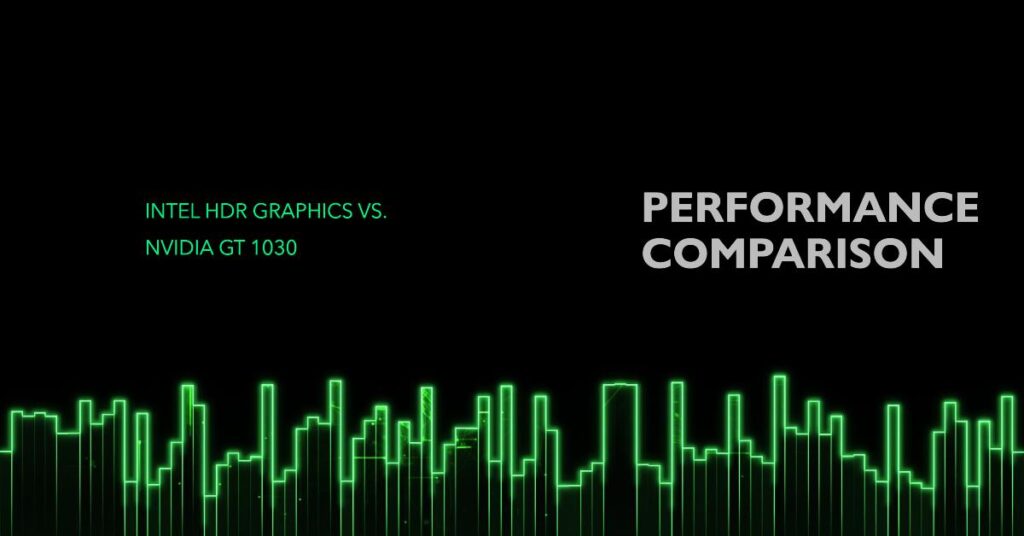Introduction
In the world of graphics processing, choosing the right GPU can significantly affect your computer’s performance, especially for tasks like gaming, video editing, and multimedia consumption. Popular options are Intel’s integrated graphics, such as Intel HDR (High Dynamic Range), and dedicated graphics cards such as the Nvidia GeForce GT 1030. Scenarios in which each shines. Whether you’re a casual gamer, creative professional, or someone looking to improve your media experience, understanding the difference between Intel HDR and Nvidia 1030 can help you make an informed decision.
Table of Contents
In-Depth Analysis
1. Overview of Intel HDR and Nvidia 1030
Intel HDR (High Dynamic Range) Graphics
Intel HDR has an impact on the graphics capabilities built into Intel’s processors those in the 8th generation and beyond. Though these integrated graphics aren’t standalone components, they offer enough power to handle everyday tasks such as HD video playback casual gaming, and simple content creation. Intel’s emphasis on productivity makes HDR graphics an attractive option for users who want to save energy and those who prefer a compact, budget-friendly solution.
The Nvidia GeForce GT 1030 launched in 2017, is a standalone graphics card that uses Nvidia’s Pascal architecture. This budget-friendly GPU outperforms many integrated graphics solutions making it a good choice for users who want to boost their graphics capabilities a bit. People often pick the GT 1030 to play simple games, watch media, and speed up certain programs that can use hardware acceleration.
2. Performance Comparison

Gaming Performance
When we talk about gaming, the Nvidia GT 1030 performs better than Intel HDR graphics. Intel HDR can handle easier games and older titles with lower settings, but the GT 1030 gives you a stronger experience. It can run newer games on low to medium settings and deliver a smoother steadier frame rate. Take games like “Fortnite” and “Rocket League” for example. They work much better on the GT 1030 giving you playable frame rates at 720p or 1080p resolutions.
Multimedia and Content Creation
Intel HDR graphics work well for playing videos and can handle 4K UHD resolution, which makes them good for streaming and basic video editing. But the Nvidia GT 1030 is better for multimedia jobs when it comes to speeding up encoding and decoding with hardware. This is because of Nvidia’s NVENC technology. So, if you’re creating content and using video editing programs like Adobe Premiere Pro, the GT 1030 is a smarter pick. It can cut down the time it takes to render videos.
Power Efficiency and Thermals
A key benefit of Intel HDR graphics is that they don’t use much power, since they’re built right into the CPU. This setup results in less overall power use and heat production, which makes them great for laptops and small systems. On the flip side, the Nvidia GT 1030, as a separate card, uses more power – usually about 30W – and needs proper cooling. While the GT 1030 is still pretty energy-efficient compared to more powerful GPUs, it might not work as well in very small or fanless systems.
3. Practical Tips and Actionable Insights

Picking the Best Option
- For Casual Users: If you browse the web, watch videos, and do some basic office work, Intel HDR graphics give you a cheap and power-saving option. These graphics come built into many Intel chips so you don’t need a separate GPU. This cuts down on costs and makes your system simpler.
- For Gamers and Creators Watching Their Wallet: If you want to play some games or try your hand at video editing, the Nvidia GT 1030 steps up the performance from Intel HDR. It’s a budget-friendly upgrade for desktops that gives you better frame rates and speeds up processing when you’re making content.
- Check Your Setup: When upgrading to a GT 1030, make sure your computer has enough power and stays cool. While it doesn’t need as much juice as beefier graphics cards, it still demands more than what’s built into your computer.
- Staying Up-to-Date: If you want your computer to keep up with new software for a while, getting a separate graphics card like the GT 1030 might give you more options and better performance as programs get more demanding.
4. Structured Format: Key Specifications Comparison
| Feature | Intel HDR Graphics | Nvidia GeForce GT 1030 |
|---|---|---|
| Architecture | Integrated | Pascal |
| Release Year | Varies by CPU Generation | 2017 |
| Core Count | Varies | 384 CUDA Cores |
| Base/Boost Clock | Varies | 1227 / 1468 MHz |
| Memory | Shared with system RAM | 2GB GDDR5 / DDR4 |
| Power Consumption | Very low | ~30W |
| 4K Support | Yes | Yes |
| Gaming Performance | Limited | Good for low settings |
| Video Playback | Excellent | Excellent with NVENC |
FAQs
Q1: Can Intel HDR graphics handle 4K video playback? Yes, Intel HDR graphics can efficiently handle 4K video playback, making them suitable for watching high-resolution content on compatible displays.
Q2: Is the Nvidia GT 1030 good for gaming? The Nvidia GT 1030 is an entry-level graphics card that can handle light gaming and older titles at low to medium settings. It is not suitable for high-end gaming but offers a good experience for less demanding games.
Q3: Do I need a separate power connector for the Nvidia GT 1030? No, the Nvidia GT 1030 does not require an external power connector. It draws power directly from the motherboard, making it easy to install.
Q4: Can I upgrade my laptop’s Intel HDR graphics to Nvidia GT 1030? Upgrading a laptop’s integrated graphics to a discrete GPU like the Nvidia GT 1030 is generally not possible due to hardware limitations and the design of most laptops.
Q5: Which is more cost-effective, Intel HDR or Nvidia GT 1030? Intel HDR graphics are more cost-effective as they come integrated with the processor, eliminating the need for a separate GPU purchase. However, the Nvidia GT 1030 offers better performance for gaming and multimedia tasks, which may justify the additional cost for some users.
Conclusion
Choosing between Intel HDR and Nvidia GT 1030 depends on your specific needs and use cases. Intel HDR graphics offer a budget-friendly, power-efficient solution for everyday computing and media consumption. In contrast, the Nvidia GT 1030 provides a valuable performance boost for gaming and content creation, making it an excellent choice for users looking to enhance their multimedia experience. By understanding the strengths and limitations of each option, you can make an informed decision that best suits your requirements.


Pingback: What PC Does MrBeast Use? A Deep Dive into the Hardware Behind the Viral Content -